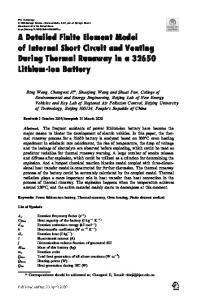Temperature Profiles in a Finite Element Thermal Model of the Prostate Region Under Hyperthermia Treatment
- PDF / 906,230 Bytes
- 6 Pages / 420.48 x 639 pts Page_size
- 74 Downloads / 305 Views
TEMPERATURE PROFILES IN A FINITE ELEMENT THERMAL MODEL OF THE PROSTATE REGION UNDER HYPERTHERMIA TREATMENT
Indira Chatterjee*, Roy E.Adams* and Namdar Saniei*" * Department of Electrical Engineering, University of Nevada, Reno, NV 89557
** Department of Electrical Engineering, University of California, Davis, CA 95617 ABSTRACT
The detailed transient temperature distribution in an inhomogeneous model of a cross section through the prostate region of the human body undergoing hyperthermia treatment for cancer has been calculated. The finite element method has been used to solve the bioheat transfer equation. A commercially available finite element software package called ANSYSO has been adapted to the present problem. The model consists of 523 triangular elements and incorporates a tumor in the prostate.The hyperthermia device under test is an Annular Phased Array consisting of dipole antennas. The model is surrounded by a bolus of deionized water. The calculated electromagnetic energy distribution is input into the bioheat transfer equation and the resulting temperature distributions calculated. The increase in blood perfusion rates due to heating is incorporated into the model. Detailed transient temperature profiles in the finite element model are presented for various values of blood perfusion rates in the tumor and surrounding tissues. It is observed that the Annular Phased Array is effective in raising the temperature of the tumor to therapeutic values. INTRODUCTION
Hyperthermia is a therapeutic technique in cancer treatment which has received increasing attention in recent years [1,2]. Elevated temperatures in the range 42-50o C have been found to produce necrosis in tumors [3]. One of the most difficult problems faced in clinical hyperthermia is the determination of detailed temperature profiles both in and around normal and tumor tissues of the patient. It is possible during treatment to invasively sample temperatures using probes, at only a few selected locations. Hence it is very useful and necessary to create mathematical models of the human body to predict detailed temperature distributions resulting from a particular treatment protocol. This paper discusses the application of the bioheat transfer equation to a model of a cross section through the prostate. The model has been created from a published Computerized Tomography (CT) scan of a section of a male pelvis [4]. The bioheat transfer equation is solved by the finite element method using a commercially available software package called ANSYS [5]. A short description of this package is given in the next section. Thermoregulation by blood flow which plays a critical role in the effectiveness of the hyperthermia treatment has been included in the model. The hyperthermia applicator under test is an Annular Phased Array (APA) [6] consisting of eight short dipoles surrounding the section of the human body under treatment. The electromagnetic energy deposited in the cross section was obtained from researchers at the University of Utah [7]. The method us
Data Loading...










